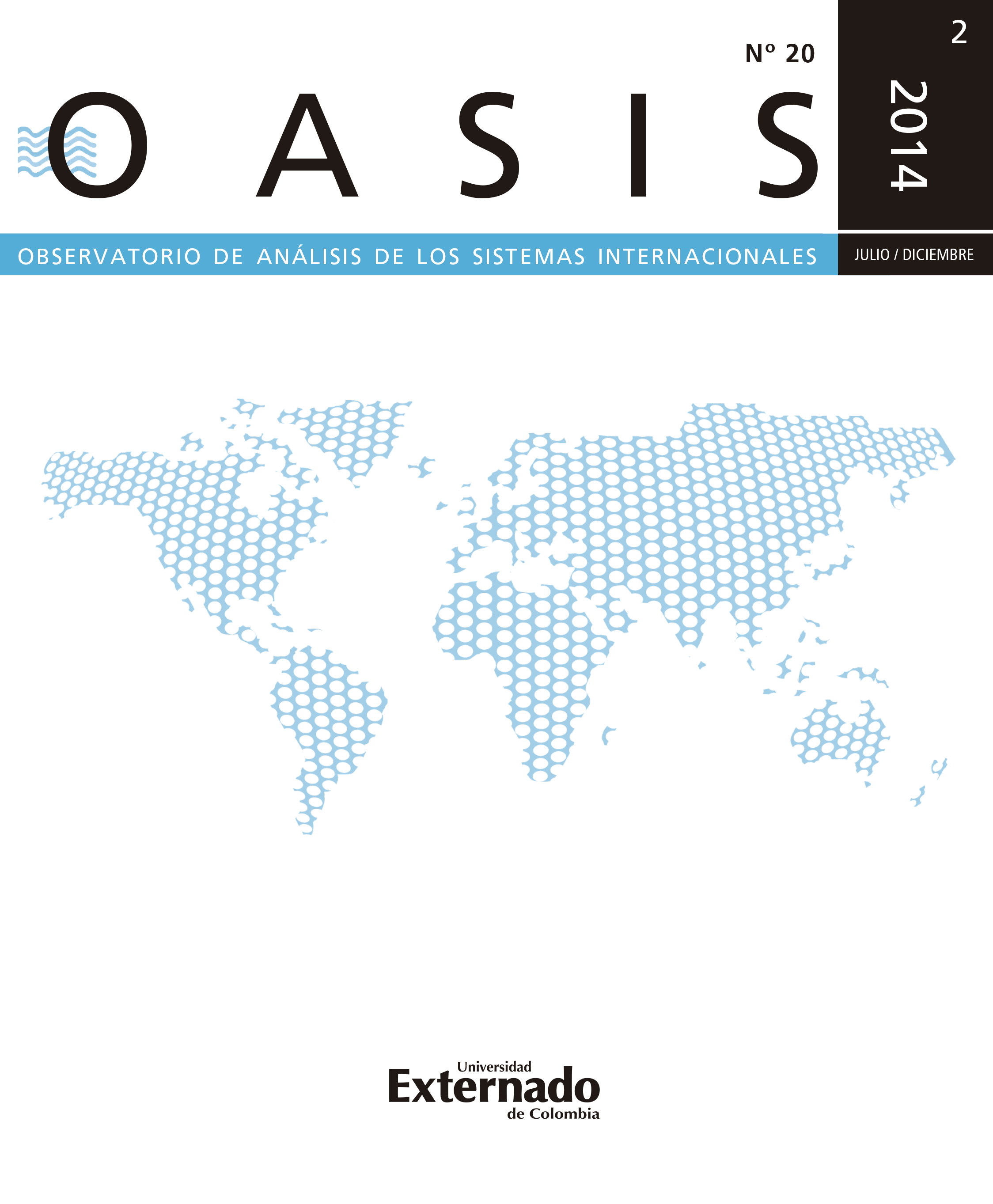Asymmetric Warfare: A State vs Non-State Conflict
Asymmetric Warfare: A State vs Non-State Conflict
Contenido principal del artículo
Resumen
Asymmetry in warfare is not a new phenomenon. Historically, it has been observed that on various occasions there has been a marked difference in the relative military power and strategy of the warring states. However, in the post 9/11 era, it has been observed that the character and nature of war itself is changing particularly amid the wars between state and non-state actors. The usage of unconventional tools and tactics, be it guerrilla warfare or terrorism or irregular warfare or any other forms are becoming more synonymous with non-state entities. All this is leading to a composition of warfare in which a non-state actor is using asymmetric methods to target the state’s vulnerabilities to achieve disproportionate effect. This paper debates the notion of Asymmetric Warfare, the characters of actors involved and the nature of the state’s response in the 21st century.
Palabras clave
Descargas
Detalles del artículo
Referencias / Ver
Allen, R. H. (n.d.). Asymmetric Warfare: Is the Army Ready? Retrieved from: http://amscportal.belvoir.army.mil/articles/97-3/1allen.htm.
Alred, M. A. (1995, April). Analysis Of Joint Doctrine: Should It Remain Directive? Global Security. Retrieved from: http://www.globalsecurity.org/military/library/report/1995/ama.htm.
Ancker, C. C. & Burke, L. C. (2003, July-August). Doctrine for Asymmetric Warfare. Military Review, 83(4). Retrieved from: http://www-cgsc.army.mil/milrev/download/english/JulAug03/ancker.pdf.
Arreguín-Toft, I (n.d.). How the Weak Win Wars: A Theory of Asymmetric Conflict. Retrieved from: http://www.cambridge.org/uk/catalogue/catalogue.asp?isbn=0521548691.
Asprey, R. B. (1975). War in the Shadows: The Guerilla History. London: Macdonald and Jane’s.
Assymmetric Warfare. (n.d.). Wikipedia. Retrieved from: http://en.wikipedia.org/wiki/Asymmetric_warfare.
Bennett, B. W. et al. (1998). What Are Asymmetric Strategies? Santa Monica, CA: Rand Corporation.
Bhonsle, R. (2004). India’s National Security The Asymmetrical Challenges. New Delhi: USI-Knowledge World.
Bishara, M. (2002, April 26). The Israelisation of America’s war. Retrieved from: http://www.mediamonitors.net/bishara3.html.
Bishara, M. (n.d.). An Enemy With No Forwarding. Retrieved from: http://www.chirstusrex.org/www1/icons/bishara.html.
Blank, S. (2004). Rethinking the Concept of Asymmetric Threats in U.S. Strategy. Comparative Strategy, 23, 345-346.
Bunker, R. J. (1999). Unconventional Warfare Philosophers. Small Wars and Insurgencies, 10(Winter), 136.
Carthage. (n.d.). Carthage. Retrieved from: http://www.carthage.edu/dept/outis/carthage.html.
Cassidy, R. M. (2003, July-August). Renaissance of the Attack Helicopter in the Close Fight. Military Review, 83 (4).
Chaliand, G. (1994). The Art of War in World History. London: University of California Press.
Clausewitz, C. V. (1984). On War. Princeton, New Jersey: Princeton University Press.
Clodfelter, M. (2002). Airpower versus Asymmetric Enemies. Air and Space Power Journal, 16(3). Retrieved from: http://www.airpower.au.af.mil/airchronicles/apj/apj02/fal02/clodfelter.html.
Craig, C. (n.d.). Asymmetrical Warfare and the Transnational Threat: Relearning the Lessons from Vietnam. Retrieved from: http://198.231.69.12/papers/amsc1/006.html.
Creveld, M. V. (1991). The Transformation of War. New York: The Free Press:.
Dinstein, y. (1994). War, Aggression and Self-Defence. Cambridge: Grotius Publications.
Dninet. (n.d.). Fourth generation warfare. Retrieved from: http://www.d-n-i.net/second_level/fourth_generation_warfare.htm.
Freedman, L. (1998). The Revolution in Strategic Affairs. Oxford: Oxford University Press.
Global Issues. (n.d.). Global Issues. Retrieved November: http://www.global-issues.net/In_Depth/conflict1.htm.
Goulding, V. J. (2000-01). Back to the Future with Asymmetric Warfare. Parameters, 30(4), pp. 21-30.
Government of the United States. (2009). Joint Strategy Review 1999. Washington, DC: The Joint Staff.
Gray, C. H. (1997). Postmodern War. London: Routledge.
History of Warfare. (n.d.). Wikipedia. Retrieved from: http://en.wikipedia.org/wiki/History_of_warfare.
Hughes, L. G. (1998, January 28). Global Threats and Challenges: The Decades Ahead. Retrieved from: http://www.infowar.com/civil_de/civil_022798a.html-ssi.
Kaldor, M. (1999). New and Old Wars. Cambridge: Polity Press.
Katzenbach, E. (1962). Time, Space and Will: Politico-Military Strategy of Mao Tse-tung. In Green, L. C. The Guerrilla and How to Fight Him. New York: Frederick A Praeger Inc.
Khan, J. (2005). Probing War and Warfare. New Delhi: A.P.H. Publishing House.
Kissinger, H. (1994). Diplomacy. London: Simon & Schuster. Kissinger, H. A. (1969, January). The Vietnam Negotiations. Foreign Affairs, 47(2), p. 214.
Kolet, K. K. (2001, July/September). Asymmetric Threats to the United States. Comparative Strategy, 20(3), 277-292.
Libicki, M. C. (1997). Defending Cyberspace, and Other Metaphors. Washington DC: National Defense University Press.
Mack, A. (1974). The Concept of Power and its Uses in Explaining Asymmetric Conflict. London: Richardson Institute for Conflict and Peace Research.
Mack, A. (1975, January). Why Big Nations Loose Small Wars: The Politics of Asymmetric Conflict. World Politics, 27(2), p. 188.
Mack, A. (1975). Why Big Nations Lose Small Wars: The Politics of Asymmetric Conflict. World Politics, 27(2), 175-200.
McKenzie, K. (2000). The Revenge of the Melians: Asymmetric Warfare Threats and Next qdr. McNair Paper 62, 19.
Melanson, R. A. (2005). American Foreign Policy Since the Vietnam War. London: M.E. Sharp.
Mendel, W. (1995-96). New Forces for Engagement Policy. Joint Forces Quarterly, 25.
Metz, S. (2001, July-August). Strategic Asymmetry. Military Review, 81(23), 25.
Metz, S. (2001, July-August). Strategic Asymmetry. Military Review, 81(4), 34.
Notes on Rome. (n.d.). Emayzine. Retrieved from: http://www.emayzine.com/lectures/noteson%20Rome.htm.
Paul, T. V. (1994). Asymmetric Conflicts: War Initiation by Weaker Powers. Cambridge: Cambridge University Press.
Pillsbury, M. (1998). Chinese Views of Future Warfare. Washington: National Defense University Press.
rand. (n.d.). The Role of External Support in Insurgent Conflicts, News From Retrieved from: http://www.rand.org/publications/news/releases/insurgent.html.
Rosen, S. (1972). War Power and the Willingness to Suffer. In B. M. Russett, Peace, War and Numbers. Beverly Hills: Sage.
Singh, S. (1995). Limited War. New Delhi: Lancer Books.
Staten, C. L. (n.d.). Asymmetric warfare, the Evolution and Development of Terrorism: The Coming Challenge For Emergency and National Security Forces. Retrieved from: http:/www.emergency.com/asymetrc.htm.
Staten, C. L. (n.d.). Asymmetric Warfare, the Evolution and Devolution of Terrorism; The Coming Challenge For Emergency and National Security Forces. Retrieved from: http://www.emergency.com/asymetrc.htm.
Tzu, S. (1994). The Art of War. (R. D. Sawyer, Trans.) Oxford: Westview Press, Inc.
UN Global Security. (n.d.). Retrieved November 10, 2005, from http://www.un-globalsecurity.org/forum/display-message.asp?F=11&M=141&P=1History3..
History 3. (n.d.). Vietnam. Retrieved from: http://www.onethreemarines.com/VN_History3.htm.
Walzer, M. (2000). Just and Unjust War. Portlan: Book News, Inc:. War. (n.d.). Encarta MSN. Retrieved from: http://encarta.msn.com/encyclopedia_761568576/War.html.




